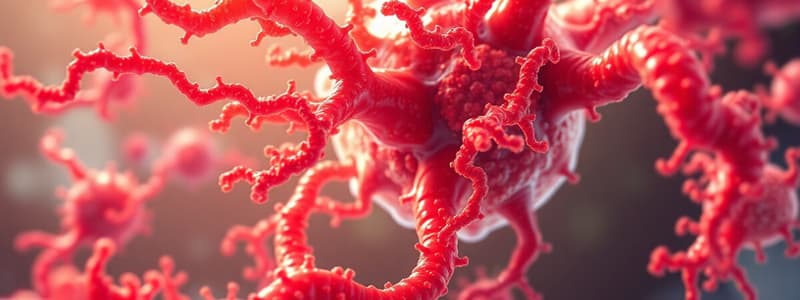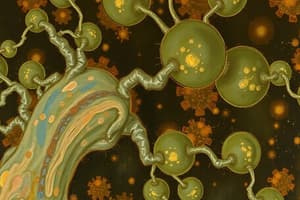Podcast
Questions and Answers
What is the primary role of bacterial capsules in the context of pathogenic infections?
What is the primary role of bacterial capsules in the context of pathogenic infections?
- Promote the multiplication of pathogens
- Facilitate adherence to host cells (correct)
- Inhibit the growth of virulence factors
- Enhance the invasiveness of bacterial agents
Which mechanism is primarily employed by pathogens to adhere to host tissues?
Which mechanism is primarily employed by pathogens to adhere to host tissues?
- Fimbriation (correct)
- Spores formation
- Binary fission
- Lysis
What does the term 'invasiveness' refer to in the infection process?
What does the term 'invasiveness' refer to in the infection process?
- The capacity to multiply and spread at the entry site (correct)
- The mechanisms by which pathogens evade the immune response
- The resulting local or systemic damage in the host
- The ability to produce toxins
Which part of the infection process is characterized by the production of toxins?
Which part of the infection process is characterized by the production of toxins?
What is the primary purpose of Gram staining in relation to microbial pathogenesis?
What is the primary purpose of Gram staining in relation to microbial pathogenesis?
What is an ideal outcome of the multiplication phase in the microbial infection process?
What is an ideal outcome of the multiplication phase in the microbial infection process?
How do pathogens generally achieve systemic damage during an infection?
How do pathogens generally achieve systemic damage during an infection?
What is likely a consequence of pathogen adherence to skin or mucosa?
What is likely a consequence of pathogen adherence to skin or mucosa?
What role does the adherence of pathogenic bacteria play in colonization and disease?
What role does the adherence of pathogenic bacteria play in colonization and disease?
What surfaces do pathogenic bacteria commonly adhere to?
What surfaces do pathogenic bacteria commonly adhere to?
How does titanium dioxide (TiO2) work in antibacterial nanofabrication?
How does titanium dioxide (TiO2) work in antibacterial nanofabrication?
Why are biofilms formed by pathogenic bacteria challenging to treat?
Why are biofilms formed by pathogenic bacteria challenging to treat?
What is the significance of microbial infection with respect to prosthetic joint infections (PJIs)?
What is the significance of microbial infection with respect to prosthetic joint infections (PJIs)?
Which type of bacteria has titanium dioxide shown considerable promise in destroying on contact?
Which type of bacteria has titanium dioxide shown considerable promise in destroying on contact?
What is a feature of natural surfaces that can inhibit bacterial attachment?
What is a feature of natural surfaces that can inhibit bacterial attachment?
What mechanism is primarily responsible for the puncturing of bacterial cells by titanium dioxide nanostructures?
What mechanism is primarily responsible for the puncturing of bacterial cells by titanium dioxide nanostructures?
What procedure is often required for successful treatment of prosthetic joint infections (PJIs)?
What procedure is often required for successful treatment of prosthetic joint infections (PJIs)?
What might prevent prosthetic joint infections (PJIs) according to the discussed research?
What might prevent prosthetic joint infections (PJIs) according to the discussed research?
What is crucial for pathogenic microbes to establish infection in a host?
What is crucial for pathogenic microbes to establish infection in a host?
How do pathogenic microbes typically overcome the immune defenses of the host?
How do pathogenic microbes typically overcome the immune defenses of the host?
What role do bacterial capsules play in host-pathogen interactions?
What role do bacterial capsules play in host-pathogen interactions?
What structural component may be involved in the pathogenicity of Staphylococcus aureus?
What structural component may be involved in the pathogenicity of Staphylococcus aureus?
What type of surface modification could potentially reduce biofilm formation?
What type of surface modification could potentially reduce biofilm formation?
Which mechanism is a fundamental aspect of microbial pathogenesis?
Which mechanism is a fundamental aspect of microbial pathogenesis?
Flashcards are hidden until you start studying
Study Notes
Human - Pathogen Interactions
- Pathogens infect the body to begin parasitism
- They must adhere to host tissues
- They must overcome immune defenses
- Microbial colonization and invasion are prohibited by the immune system
- Microbes require adherence to host tissues and overcoming immune defenses to successfully infect
- Staphylococcus aureus cells are known to bind to Fibrinogen
- Adhesins are bacterial structures that bind to host cells
- SdrG is an adhesin that is able to bind to fibrinogen
- Fibrinogen is a protein in blood that can form clots
- Adhesins bind to fibrinogen and host cells
- Adhesins can cause clot formation
- This process is crucial for pathogenesis and parasitism
- This process allows microbes to avoid immune defenses
- The interactions between the host and pathogen are very intricate and multi-faceted
Studying That Suits You
Use AI to generate personalized quizzes and flashcards to suit your learning preferences.




